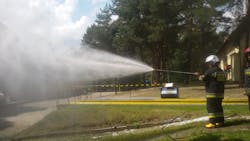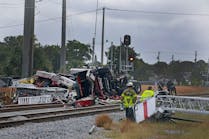Olsztyn’s Fire Training Centre has a leading role in Poland when it comes to stimulating discussion and examining “out-of-the-box” approaches to firefighting. Our philosophy is to foster learning.
A colleague from Sweden suggested conducting experiments on the use of high-pressure/low-flow water fog applied from the exterior, prior to entry. These discussions and his experience with this tactic formed the basis of these experiments. We decided to examine three high-pressure/low-flow systems. (See Table 1: High-Pressure/Low-Flow Systems)
After examining the three systems, we decided to focus our experiments on the Fognail using a high-pressure hose reel line, as this is a common option in most European countries. The Fognail piercing nozzle is available in two models: 1) the Attack, which provides stream with a 30-degree cone angle, and approximately 30 feet of reach, as illustrated in Figure 1, and 2) the Restrictor Fognail, which provides an extremely wide cone angle and is effective against fires in void spaces.
Experiment set-up
These experiments were conducted in a 1½-story house with a small basement as shown in Figure 2. The house was of ordinary construction (brick, wood-frame roof floor systems). Most of the rooms were lined with wood.
The following instrumentation was used to gather objective data on the fire and effects of high-pressure/low-flow water application.
- A set of five thermocouples placed in different measurement points in the fire compartment and the adjacent room
- A clock measuring the time of the evolution
- A video camera on a tripod (stationary picture)
- A helmet camera (mobile recording)
- A drone camera (aerial overview of the evolution)
- A thermal imaging camera (TIC) with recording option
Thermocouples were placed as illustrated in Figures 4 and 5.
The stationary camera was placed to see two sides of the structure, including the window to the fire room, and two displays (elapsed time and temperatures). Another piercing lance (Mist-er Killer) was used as a precaution to extinguish any extension into the roof void.
The experiments
Evolutions were started 10 minutes after ignition, based on probable response time. First alarm would normally include two engines and, in some cases, an aerial ladder with a minimum of seven firefighters. Our scenario anticipated the following points:
- After arriving, the officer does a 360 with a TIC and identifies the fire room, wind direction and strength, existing and possible flow paths, confirms there are no occupants inside. The fire is on the second floor, ventilation limited, windows intact.
- While a crew prepares to make entry, firefighters place a ladder next to the window and use a power drill to make a hole. Less than 2 minutes after arrival, the fognail was inserted and fog was applied for 4 minutes (580 psi and 21 gpm). Temperatures dropped to less than 329 degrees F (165 degrees C), making it impossible for gases to ignite. Note: Normally the hole would be drilled in the window frame. But the drill used in the experiments was designed for masonry, so the hole was drilled in the wall. Time to complete the hole was approximately 10 seconds.
- After applying water through the fognail for 4 minutes, water is stopped and a 2-inch handline with a selectable flow nozzle (22–110 gpm, 115 psi) goes in. Crew holds in the stairwell and calls for PPV to clear the structure. First window is opened (Side B) and approach path is cleared; water is applied from the door to the fire room. Later, a window on Side D is taken and the structure is cleared of smoke, and the fire is extinguished.
After peaking at 300 seconds, the temperature in the fire compartment begins to drop as the fire becomes ventilation-limited. Application of water through the fognail significantly improves thermal conditions. Temperature increases after application of PPV, but followed by quick water inside poses no threat.
Conclusions
Based on the data recorded on the thermocouples, video and my experience as the firefighter on the nozzle in this experiment, we came to the following conclusions.
In the scenario, we used a significant fire load, with one sofa, approximately 1m3 wood and particleboard pieces in a stack. In addition, there were combustible linings on the walls and the ceiling, and a wooden floor covered by carpet. This setup created ventilation-limited conditions, and even though the attack began while the temperatures were not extreme, they were constantly growing and already started posing a threat due to the flammability of smoke and high concentration of unburned hydrocarbons from the pyrolysis process. These conditions may be favorable to create either a backdraft or smoke explosion. By cooling the smoke down, the threats were minimized.
Water absorbs energy as it is heated from ambient temperature to its boiling point at 212 degrees F (100 degrees C). However, much more energy is absorbed when water is vaporized from its liquid form into steam. When water is vaporized into steam it expands substantially. However, as energy is removed from the hot fire gases, they are cooled and they contract. This can be explained by the ideal gas law pV-nRT, where p is pressure, V is volume, n is number of moles, R is the gas constant and T is the temperature. However, the simple, no-math explanation is that the volume of a gas varies directly with its temperature (if the thermodynamic temperature of a gas is doubled, the volume will double and if the thermodynamic temperature of a gas is reduced by half, the volume will be reduced by half). It is a bit more complicated, but this illustrates the point.
Because it requires much more energy to increase the temperature of water and vaporize it into steam than it does to reduce the temperature of fire gases, water vaporized in the hot gas layer will result in a reduction of total volume (contracting the hot gas layer). On the other hand, if you vaporize water on surfaces and do not take energy from the hot gas layer, the temperature of the gases will not be significantly reduced and the volume of steam is added to the hot gases, increasing the total volume.
How much water is vaporized in the hot gas layer is dependent on many factors including, droplet size and velocity as well as compartment geometry. Effective use of water fog for gas cooling can result in a contraction of hot gases, decrease the flammability of the fire gases by dilution and addition of thermal ballast. This is why I decided to say in the title that “sometimes less is more.” What needs to be remembered is that this requires a conscious action, good selection of equipment and thorough training. In such conditions gas cooling is effective.
We made some mistakes. Let us remember that fog should evaporate in gases (contracting them) and not on surfaces, only creating steam and adding to the volume. In our burn, we were not able to avoid that, and that is something we would like to correct the next time. Nevertheless, the graph shows that the technique worked quite nicely. If we look in literature, we will find that approximately 30 percent of water should evaporate in gases to maintain a relatively constant volume inside an enclosure. If the ratio is more, the volume will contract. If it is less, it will expand. I think it is a comfortable value to keep in one’s mind. While we always try for things to work as best as they can, if we are not always super precise, our goals should be achieved anyway.
In sum
There are many interesting solutions out there and all have their place in firefighting. We must never stop learning to be professional and to serve our citizens to the best of our abilities, keeping in mind that our own safety should not be disregarded as well.
To see the stunning effects of gas cooling with fog, please go to my YouTube channel (Szymon Kokot-Gora) and watch the video with a 110-psi (European standard) 50-gpm fog nozzle attached to a 2-inch handline. At 8:10, the effect of gas cooling pulls the door inside a room. While this deliberate effect was a result of testing and is not likely to be repeated exactly in real-life situations, it proves beyond any doubt that skillful gas cooling can, in some situations, bring amazing effects. You may think I am “one of those fog nozzle zealots” who cannot be told otherwise. On that same YouTube channel, you will find us training with a stacked tip smoothbore nozzle (50–80 psi, 210–416 gpm). I see absolute value in that because IT WORKS for me in some fireground situations, just like fog does in SOME OF THEM. I encourage you to examine my claims. Just like myself with the smoothbore, I think some of you will be surprised with the outcomes.
I would like to thank Ed Hartin for his help with the editing of this article and his ongoing support.
References
Grimwood, P., Hartin, E., McDonough, J., Raffel, S. “3D Fire Fighting: Training, Techniques & Tactics.” 2005.
Särdqvist, S. “Water and Other Extinguishing Agents.” Swedish Rescue Services Agency. 2002.
Lanca gaśnicza Mist-er Kiler: https://youtu.be/ztrmC8o2UhU?t=7m12s
Szymon Kokot-Góra
Jr. Brigadier Szymon Kokot-Góra (Poland) is a firefighter since 1999. He holds engineer’s and master’s degrees in fire safety and college diplomas in OHS and pedagogy. He is a founder of cfbt.pl and Projekt LIDER, and is also a member of Shut Up And Train. Since September 2016, he has served as a Training Officer in CERN Fire Brigade (Switzerland/France).






